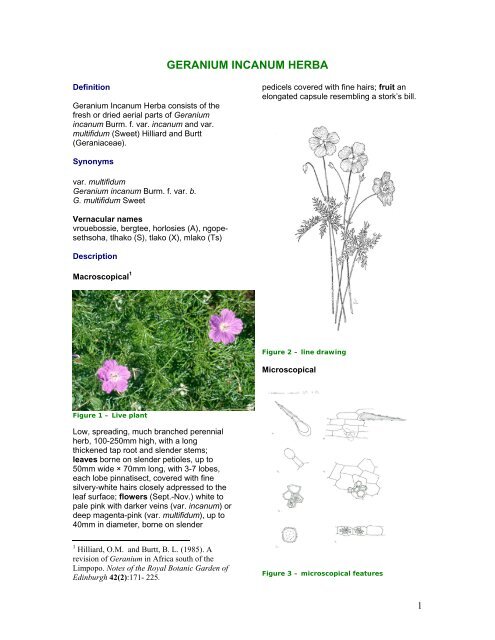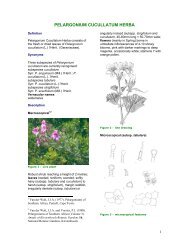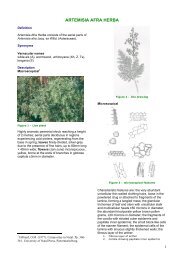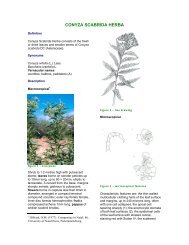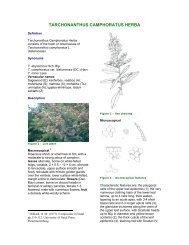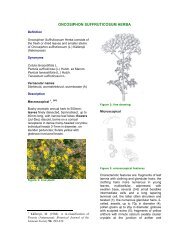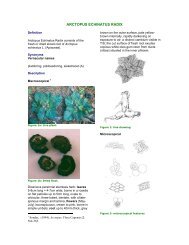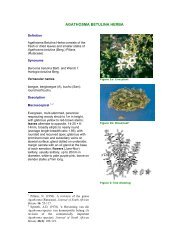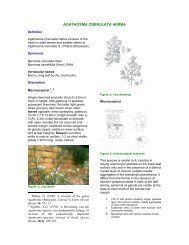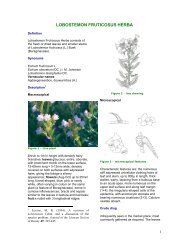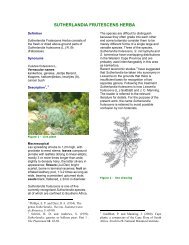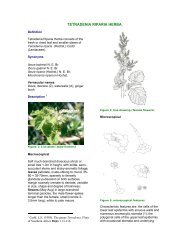GERANIUM INCANUM HERBA - PlantZAfrica
GERANIUM INCANUM HERBA - PlantZAfrica
GERANIUM INCANUM HERBA - PlantZAfrica
You also want an ePaper? Increase the reach of your titles
YUMPU automatically turns print PDFs into web optimized ePapers that Google loves.
Definition<br />
Geranium Incanum Herba consists of the<br />
fresh or dried aerial parts of Geranium<br />
incanum Burm. f. var. incanum and var.<br />
multifidum (Sweet) Hilliard and Burtt<br />
(Geraniaceae).<br />
Synonyms<br />
var. multifidum<br />
Geranium incanum Burm. f. var. b.<br />
G. multifidum Sweet<br />
Vernacular names<br />
vrouebossie, bergtee, horlosies (A), ngopesethsoha,<br />
tlhako (S), tlako (X), mlako (Ts)<br />
Description<br />
Macroscopical 1<br />
Figure 1 – Live plant<br />
Low, spreading, much branched perennial<br />
herb, 100-250mm high, with a long<br />
thickened tap root and slender stems;<br />
leaves borne on slender petioles, up to<br />
50mm wide × 70mm long, with 3-7 lobes,<br />
each lobe pinnatisect, covered with fine<br />
silvery-white hairs closely adpressed to the<br />
leaf surface; flowers (Sept.-Nov.) white to<br />
pale pink with darker veins (var. incanum) or<br />
deep magenta-pink (var. multifidum), up to<br />
40mm in diameter, borne on slender<br />
1 Hilliard, O.M. and Burtt, B. L. (1985). A<br />
revision of Geranium in Africa south of the<br />
Limpopo. Notes of the Royal Botanic Garden of<br />
Edinburgh 42(2):171- 225.<br />
<strong>GERANIUM</strong> <strong>INCANUM</strong> <strong>HERBA</strong><br />
pedicels covered with fine hairs; fruit an<br />
elongated capsule resembling a stork’s bill.<br />
Figure 2 – line drawing<br />
Microscopical<br />
Figure 3 – microscopical features<br />
1
Characteristic features are: the very<br />
numerous unicellular, rigid, thin-walled warty<br />
clothing hairs of leaf and stem, up to 500<br />
microns long, adpressed to the leaf and<br />
stem surface or loose in the powdered herb;<br />
the small glandular trichomes of the leaf,<br />
with unicellular stalk and unicellular head up<br />
to 20 microns in diameter; the numerous<br />
small rosette aggregates of calcium oxalate,<br />
up to 16 microns in diameter, forming a<br />
crystal layer in the leaf collenchyma; the<br />
large rosette aggregates of calcium oxalate,<br />
up to 40 microns in diameter, in the<br />
parenchyma cells surrounding fibre bundles<br />
of leaf and stem, forming a crystal sheath;<br />
the vascular tissue of leaf and stem, with<br />
red-brown contents; the fairly frequent large<br />
golden-brown pollen grains, up to 70<br />
microns in diameter, with warty exine.<br />
1. Unicellular, rigid, thin-walled, warty<br />
clothing hairs of leaf and stem, up to<br />
500µ long<br />
2. Cells of upper epidermis showing<br />
adpressed hair and underlying palisade<br />
layer<br />
3. Glandular trichome of leaf, with<br />
unicellular stalk and head up to 20µ in<br />
diameter<br />
4. Collenchyma of leaf lamina with<br />
underlying thin-walled cells of<br />
mesophyll<br />
5. Calcium oxalate rosette aggregates, up<br />
to 16µ in diameter, forming a crystal<br />
layer in leaf collenchyma<br />
6. Golden-brown pollen grains, up to 70µ<br />
in diameter, with warty exine<br />
7. Calcium oxalate rosette aggregates, up<br />
to 40µ in diameter, in parenchyma cells<br />
surrounding fibre bundles of leaf and<br />
stem, forming a crystal sheath<br />
Crude drug<br />
Collected as needed or found in the market<br />
place as bundles comprising leaf, stem and<br />
flower; odour aromatic, texture soft; colour<br />
silver-grey.<br />
Geographical distribution<br />
Figure 4 – distribution map<br />
Common and widespread on flats, hill<br />
slopes and dunes of the Western and<br />
Eastern Cape Provinces. Both varieties<br />
have been recorded from the Cape<br />
Peninsula eastwards to Knysna, but only<br />
var. multifidum occurs in the Eastern Cape<br />
Province, in coastal districts as far as Port<br />
Alfred.<br />
Quality standards<br />
Figure 5 – TLC plate<br />
Identity tests<br />
Thin layer chromatography on silica gel<br />
using as solvent a mixture of toluene:diethyl<br />
ether:1.75M acetic acid (1:1:1). Reference<br />
compound cineole (0,1% in chloroform).<br />
Method according to Appendix 2a.<br />
Rf values of major compounds: 0,54 (purplegrey);<br />
0,63 (purple-brown); 0,80 (mauve);<br />
0,97 (purple); cineole: 0,77 (blue-purple)<br />
HPLC on C18 column, method according to<br />
Appendix 2b.<br />
2
Major compounds:<br />
Figure 6 – HPLC spectrum<br />
Methanol extract: (figure 6)<br />
Retention times (mins): 2.68; 12.17; 14.45;<br />
15.35; 15.89; 16.98<br />
Ethanol (70%) soluble extractive value:<br />
not less than 26, 0% (range: 26.49-30.68%)<br />
Purity tests<br />
Assay<br />
Not yet available<br />
Major chemical constituents<br />
Figure 7 – chemical constituents<br />
Microchemical tests in our laboratories<br />
indicated the presence of tannins and<br />
saponins but not of alkaloids nor of cardiac,<br />
cyanogenic or anthraquinone glycosides.<br />
The detection of tannin confirms the results<br />
of earlier studies 2 . The presence of the<br />
gallitannin geraniin is reported from other<br />
members of the genus. Further information<br />
regarding the secondary chemistry of this<br />
species is lacking.<br />
Dosage forms<br />
Used mainly as an aqueous infusion, taken<br />
orally.<br />
Medicinal uses<br />
An infusion is taken orally to relieve<br />
diarrhoea and colic, to treat venereal<br />
diseases, as an anthelmintic, to relieve<br />
bladder infections in women and for<br />
gynaecological problems e.g.<br />
dysmenorrhoea, oligomenorrhoea.<br />
Pharmacology/bioactivity<br />
No in vitro antimicrobial activity of aqueous<br />
extracts of Geranium incanum against<br />
Pseudomonas aeruginosa, Candida<br />
albicans or Mycobacterium smegmatis was<br />
observed, in the concentrations used for<br />
disc assays in our laboratories. Weak<br />
activity was noted against Staphylococcus<br />
aureus.<br />
The results of an investigation of cytotoxicity<br />
and antiviral activity of 16 South African<br />
plant species<br />
3 showed that aqueous<br />
extracts of Geranium incanum were<br />
cytotoxic at all concentrations used in the<br />
assay to HeLa, Vero, Jurkat E6.1, AA-2 and<br />
CEM-SS cells. Similar extracts, in a cell<br />
culture antiviral assay, were found to reduce<br />
the infectivity of both Coxsackie B2 virus<br />
and HSV-1. In direct in vitro antiviral assays<br />
however, extracts were unable, at noncytotoxic<br />
dilutions, to inhibit virus replication.<br />
The cytotoxicity of aqueous extracts may<br />
possibly be ascribed to the presence of<br />
polyphenols (tannins) and account for the<br />
use of Geranium incanum as an<br />
abortifacient.<br />
2 Bate-Smith, E.C. (1972). Ellagitannin content<br />
of leaves of Geranium species. Phytochemistry<br />
11: 1755-1757.<br />
3 Treurnicht, F. T. (1997). An evaluation of the<br />
toxic and potential antiviral effects of some<br />
plants used by South Africans for medicinal<br />
purposes. MSc thesis, University of<br />
Stellenbosch.<br />
3
Contraindications<br />
None recorded.<br />
Adverse reactions<br />
None reported<br />
Precautions<br />
No special precautions.<br />
Dosage<br />
An infusion may be made by adding one<br />
quarter teacupful of fresh leaves to one<br />
teacupful (180ml) of boiling water. Allow to<br />
infuse for 10 minutes, strain and drink warm.<br />
As an anthelmintic, one teacupful is taken<br />
once daily, on an empty stomach, for 10<br />
days.<br />
For the relief of diarrhoea, bladder infection<br />
or colic: one teacupful three times daily. If<br />
symptoms persist for more than three days,<br />
alternative treatment should be sought.<br />
For dysmenorrhoea: one teacupful three<br />
times daily for 2-3 days as needed.<br />
Copyright in this monograph resides with the authors, the South<br />
African National Biodiversity Institute, the South African Medical<br />
Research Council and the University of the Western Cape. It may<br />
not be reproduced in whole or in part without the written consent of<br />
the copyright holders.<br />
4


